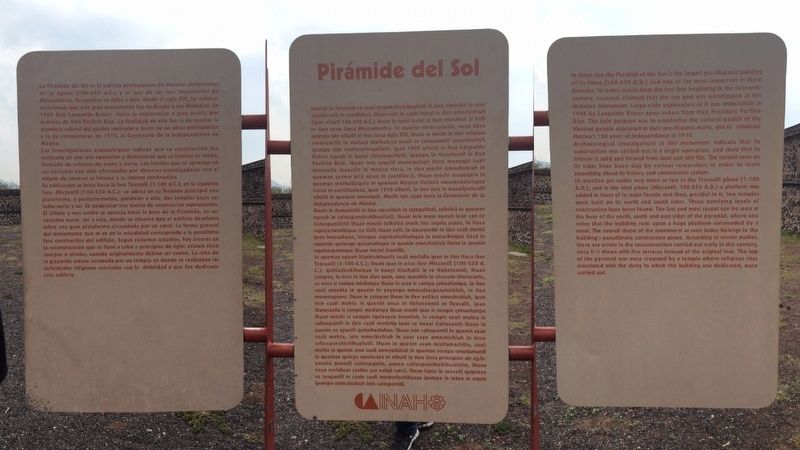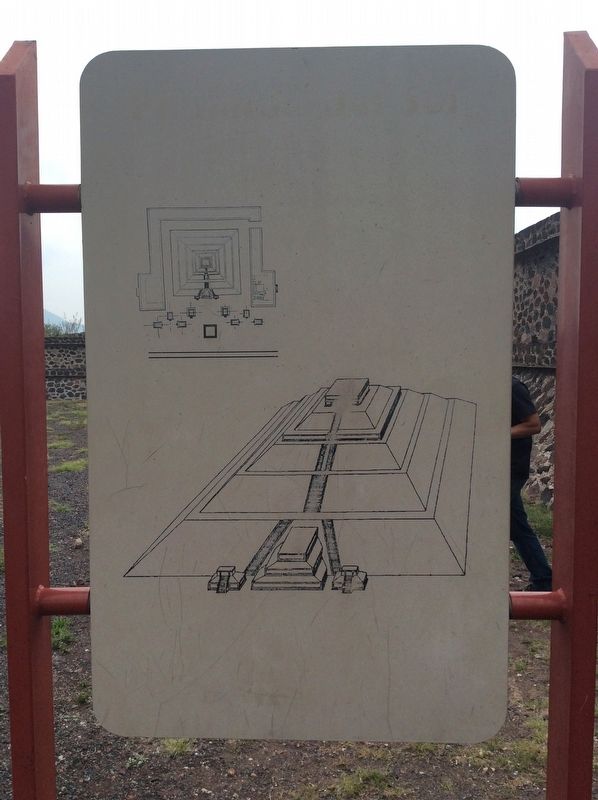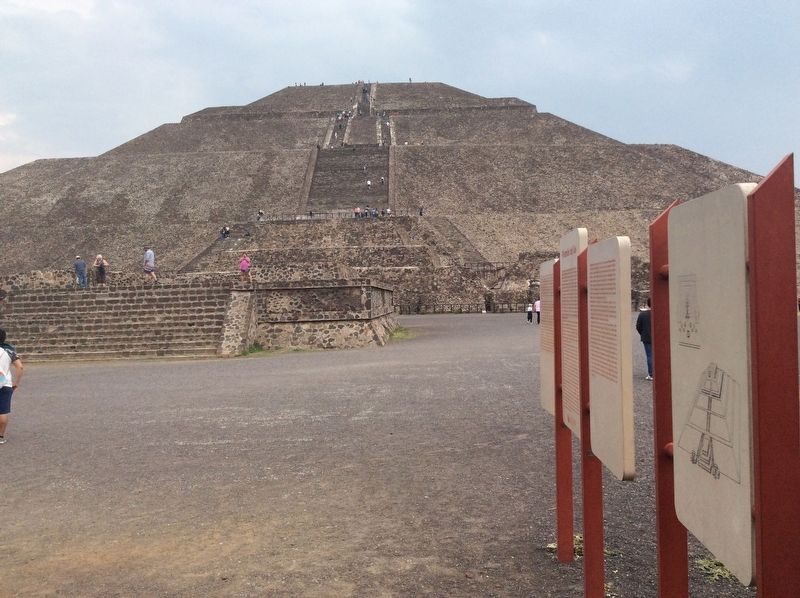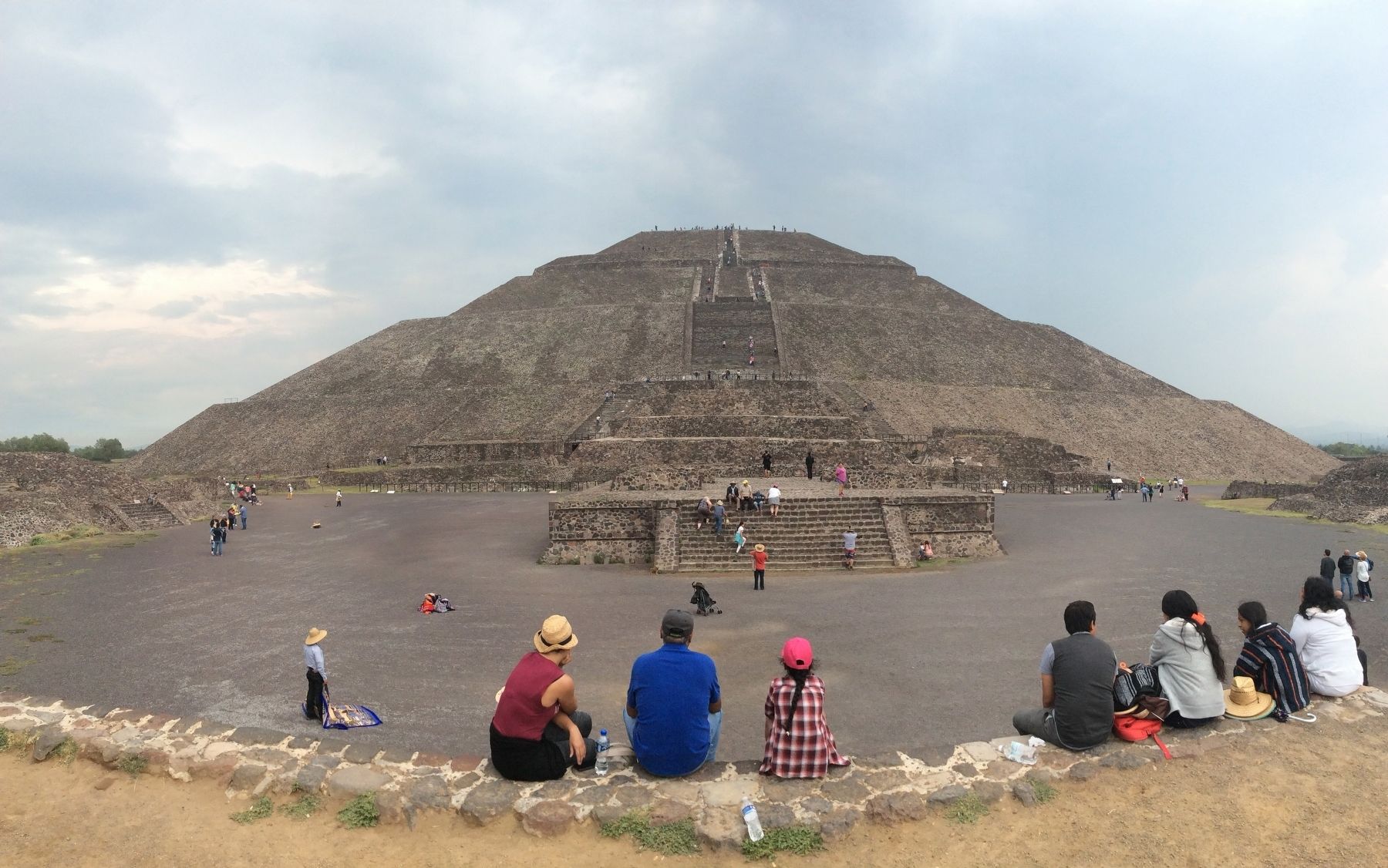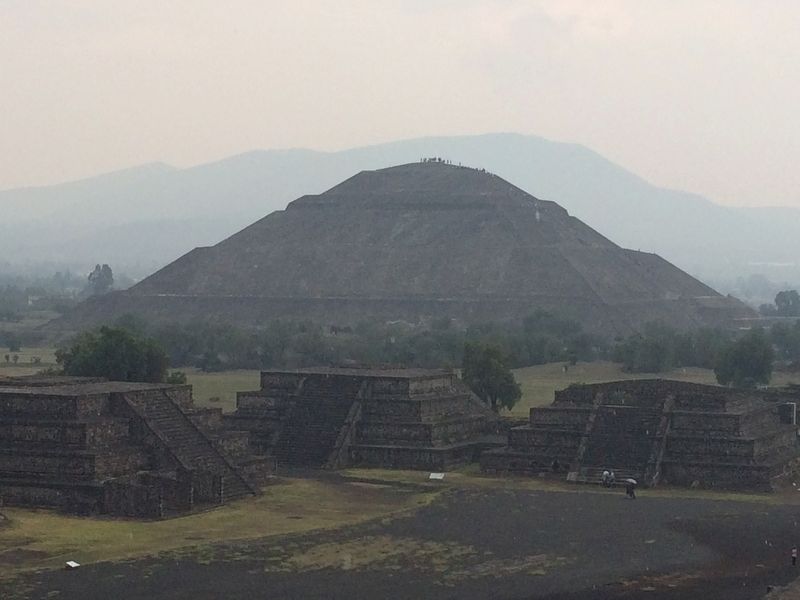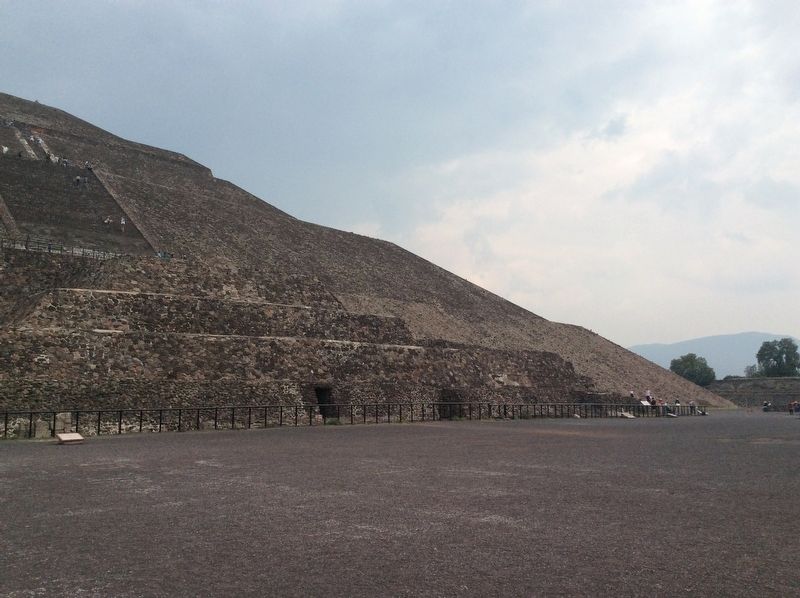Teotihuacán de Arista in Teotihuacán, Mexico State, Mexico — The Central Highlands (North America)
The Pyramid of the Sun
Pirámide del Sol
La Pirámide del Sol es el edificio prehispánico de mayores dimensiones de su época (100-650 d.C.) y es uno de los más importantes de Mesoamérica. Su nombre se debe a que, desde el siglo XVI, las crónicas mencionan que este gran monumento fue dedicado a esa divinidad. En 1905 Don Leopoldo Batres inició su exploración a gran escala, por órdenes de Don Porfirio Díaz. La finalidad de ello fue la de resaltar la grandeza cultural del pueblo mexicano a través de sus obras prehispánicas y la de conmemorar, en 1910, el Centenario de la Independencia de México.
Las investigaciones arqueológicas indican que su construcción fue realizada en una sola operación y demuestran que su interior es sólido, formado de rellenos de arena y tierra. Los túneles que se aprecian en sus costados han sido efectuados por diversos investigadores con el objeto de conocer su historia y su sistema constructivo.
Su edificación se inicia hacia la fase Tzacualli (1-100 d.C.); en la siguiente fase - Miccaotli (100-250 d.C.) - se adosa en su fachada principal una plataforma, y posteriormente, paralelos a ésta, dos templos hacia sus lados norte y sur. Se evidencian tres niveles de construcción superpuestos. El último y más tardío se aprecia hacia la base de la Pirámide, en sus costados norte, sur y este, donde se observa que el edificio desplanta sobre una gran plataforma circundada por un canal. La forma general del monumento que se ve en la actualidad corresponde a la penúltima fase constructiva del edificio. Según recientes estudios, hay errores en la reconstrucción que se llevó a cabo a principios de siglo: existen cinco cuerpos o niveles, cuando originalmente debían ser cuatro. La cima de la pirámide estuvo coronada por un templo en donde se realizaban las actividades religiosas asociadas con la divinidad a que fue dedicado este edificio.
Náhuatl:
Pirámide del Sol
Iteocal in Tonatiuh ce cuali tecpanchichihualiztli in tlen omochih in cuac ayamo acia caxtiltaca, ihuan inin in cachi hueyi in tlen omochichiuh (ipan xihuitl 100-650 d. C.) lhuan in cachi hueyi in tlen omochiuh in tlalli in tlen axan itoca Mesoamerica. In quenin motocayotia, noco tleca ipampa inin xihuitl in tlen itoca siglo XVI, ihuan in mochi in tlen mitohua innenemiliz in tlatlaca molhuiaya mach in caltepamitl omochichiuh ipampa inin teotlaneltoquiliztli. Ipan 1905 xihuitl in Don Leopoldo Batres opeuh in hueyi tlatataquiliztli, ipampa in tlanahuatli in Don Porfirio Díaz. Ihuan inin tequitl monequiaya tleca monequi cuali mixnextiz ihueyiliz in mexica tlaca, in tlen mochi omochichiuh in queman ayamo acia nican in caxtiltlaca, ihuan mochi monequia in queman molhuitizquia in queman México tlatlaca omoaquixtique
intlan in caxtiltlatlaca, ipan 1910 xihuitl, in tlen acia in macuilpohualli xihuitl in queman omochiuh. Mochi inin axan itoca in Centenario de la Independencia de México.
Mochi in tlamachtilli in tlen omochiuh in tataquiliztli, teihtitia in queman opeuh in caltecpanchichihualiztli, ihuan inin mate opeuh ipan can ce tlatecpaniliztli ihuan mochi teihtitia mach itec tepitz yatoc, in tleca oquiyectemiltique ica tlalli ihuan xalli. In tlacoyoctin in tlen cuali mohta ipan inacazhuan, ininque oquinchichiuhque in temachtique tlaca in aquintin quinequi quixmatizque in quenin omochichiuh ihuan in quenin oquitecpanoque ihuan mochi inemiliz.
In queman opeuh itlachichihualiz cuali motlalia ipan in tlen itoca fase Tzacualli (1-100 d.C.); ihuan ipan in occe fase-Miccaotli (100-250 d.C.) - quitlachichihuique in hueyi itlachaliz in ce tlaltetzontli, ihuan catepan, in occe in tlen itlan yauh, ome teocaltin in cececnin itlanacaztla, ce onca ic compa mictlampa ihuan in occe ic compa çohuatlampa. In tlen cuali moohta in quenin in yeyexpa omocaltecpanchichiuh, in tlen monenepano. Ihuan in çatepan ihuan in tlen yetlàca omochichiuh, ipan inin cuali mohta in quenin onca in tlaltetzontli in Teocalli, ipan itlanacaztla ic compic mictlampa ihuan mochi ipan ic compic cohuatlampa ihuan mochi ic com pic iquizayan tonatiuh, ic compi cuali mohta in caltecpantli in tlen cuali motlalia ipan ce hueyi tlaltezontli ihuan in quenin ce apantli quiyehualohua. Ihuan inin caltepamitl in quenin axan cuali mohta, inin omochichiuh in cuac çaye omochichiuh in occe caltecpanchichihualiztli. Ihuan in quenin axan mixtlamachilia, cuali mohta in quenin amo cuali omoyetlatlali in queman occepa omotlamanili in queman quinye opehuaya in xihuitl in tlen itoca principios de siglo: oncate macuili caltecpantin, onoco caltecpanchichihualiztin, ihuan noco melahuac cachto can nahui catca. Ihuan icpac in teocalli quipiaya ce teopantli in canin cuali moteotlachihuaya ipampa in teteo in aquin ipampa omochichiuh inin caltepamitl.
English:
Pyramid of the Sun
In sheer size the Pyramid of the Sun is the largest pre-Hispanic building of its times (100-650 A.D.) and one of the most important in Meso America. Its name comes from the fact that beginning in the sixteenth-century, accounts claimed that the sun god was worshipped at this immense monument. Large-scale exploration of it was undertaken in 1906 by Leopoldo Batres upon orders from then President Porfirio Díaz. The twin purpose was to emphasize the cultural wealth of the Mexican people expressed in their pre-Hispanic works, and to celebrate Mexico's 100 years of independence in 1910.
Archaeological investigations at this monument indicate that its construction was carried out in a single operation, and show that its interior is solid and formed from sand and dirt fills. The tunnels seen on its sides have been dug by various researchers in order to learn something about its history and construction system.
Its erection got under way more or less in the Tzacualli phase (1-100 A.D.), and in the next phase (Miccaotli, 100-250 A.D.) a platform was added in front of its main facade and then, parallel to it, two temples were built on its north and south sides. Three overlying levels of construction have been found. The last and most recent can be seen at base of the north, south and east sides of the pyramid, where one notes that the building rests upon a huge platform surrounded by a moat. The overall shape of the monument as seen today belongs to the building's penultimate construction phase. According to recent studies, there are errors in the reconstruction carried out early in this century, since it is shown with five terraces instead of the original four. The top of the pyramid was once crowned by a temple where religious rites associated with the deity to which this building was dedicated, were carried out.
Erected by Instituto Nacional de Antropología e Historia (INAH).
Topics. This historical marker is listed in these topic lists: Anthropology & Archaeology
• Architecture • Man-Made Features • Native Americans. A significant historical year for this entry is 1905.
Location. 19° 41.57′ N, 98° 50.732′ W. Marker is in Teotihuacán de Arista, Estado de Mexico (Mexico State), in Teotihuacán. Marker can be reached from Route 132, 1.3 kilometers east of Avenida Pirámides. The marker is some meters west of the the Pyramid of the Sun at the Teotihuacan Archaeological Site. Touch for map. Marker is in this post office area: Teotihuacán de Arista MEX 55880, Mexico. Touch for directions.
Other nearby markers. At least 8 other markers are within walking distance of this marker. The Meaning of the Pyramid of the Sun (within shouting distance of this marker); a different marker also named Pyramid of the Sun (about 90 meters away, measured in a direct line); A Ceremonial Incense Burner (about 90 meters away); The Importance of the Pyramid of the Sun (about 120 meters away); Teotihuacan After Its Abandonment (about 210 meters away); Teotihuacan (about 210 meters away); Construction Systems of the Pyramid of the Sun (approx. 0.2 kilometers away); The Puma Mural (approx. 0.3 kilometers away). Touch for a list and map of all markers in Teotihuacán de Arista.
Also see . . . Teotihuacan at Wikipedia. (Submitted on July 15, 2017, by J. Makali Bruton of Accra, Ghana.)
Credits. This page was last revised on December 15, 2017. It was originally submitted on July 15, 2017, by J. Makali Bruton of Accra, Ghana. This page has been viewed 207 times since then and 19 times this year. Photos: 1, 2, 3, 4, 5, 6. submitted on July 15, 2017, by J. Makali Bruton of Accra, Ghana.
